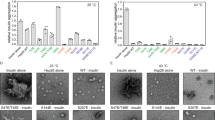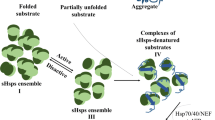Abstract
Interaction of human 14-3-3γ with the small heat shock protein Hsp20 was analyzed by means of size-exclusion chromatography and chemical crosslinking. Unphosphorylated Hsp20 and its mutant S16D mimicking phosphorylation by cAMP-dependent protein kinase did not interact with 14-3-3. Phosphorylated Hsp20 formed a tight complex with 14-3-3 in which dimer of 14-3-3 was bound to dimer of Hsp20. 14-3-3 did not affect the chaperone activity of unphosphorylated Hsp20 but increased the chaperone activity of phosphorylated Hsp20 if insulin was used as a model substrate. Estimation of the effect of 14-3-3 on the chaperone activity of Hsp20 with other model substrates was complicated by the fact that under in vitro conditions isolated 14-3-3 possessed its own high chaperone activity. Taken into account high content of Hsp20 in different muscles it is supposed that upon phosphorylation Hsp20 might effectively compete with multiple protein targets of 14-3-3 and by this means indirectly affect many intracellular processes.
Similar content being viewed by others
Abbreviations
- 14-3-3γ:
-
γ-isoform of recombinant human 14-3-3 protein
- DMS:
-
dimethylsuberimidate
- DTT:
-
dithiothreitol
- Hsp20:
-
recombinant small heat shock protein with apparent molecular mass 20 kDa
- pHsp20:
-
Hsp20 phosphorylated by cAMP-dependent protein kinase
- S16D mutant of Hsp20:
-
mutant with replacing Ser16 by Asp
- PMSF:
-
phenylmethanesulfonyl fluoride
- sHsp:
-
small heat shock proteins
References
Haslbeck M, Franzmann T, Weinfurtner D, Buchner J (2005) Some like it hot: the structure and function of small heat shock proteins. Nature Struc Mol Biol 12: 842–846
Haslbeck M (2002) sHsps and their role in the chaperone network. CMLS Cell Mol Life Sci 59: 1649–1657
Sun Y, MacRae TH (2005) The small heat shock proteins and their role in human disease. FEBS J 272: 2613–2627
Kappe G, Franck E , Verschuure P, Boelens WC, Leunissen JAM, de Jong WW (2003) The human genome encodes 10 α-crystallin related small heat shock proteins: HspB1–10. Cell Stress Chaperones 8: 53–61
Fontaine JM, Rest JS, Welch MJ, Benndorf R (2003) The sperm outer dense fiber protein is the 10th member of the superfamily of mammalian small stress proteins Cell Stress Chaperones 8: 62–69
Taylor RP, Benjamin IJ (2005) Small heat shock proteins: a new classification scheme in mammals. J Mol Cell Cardiol 38: 433–444
Gusev NB, Bukach OV, Marston SB (2005) Structure, properties, and probable physiological role of a small heat shock protein with molecular mass 20 kDa (Hsp20, HspB6). Biochemistry (Moscow) 70: 762–772
Beall AC, Kato K, Goldenring JR, Rasmussen H, Brophy CM (1997) Cyclic nucleotide-dependent vasorelaxation is associated with the phosphorylation of a small heat shock-related protein. J Biol Chem 272: 11283–11287
Rembold CM, Foster DB, Strauss JD, Wingard CJ, van Eyk JE (2000) cGMP-mediated phosphorylation of heat shock protein 20 may cause smooth muscle relaxation without myosin light chain dephosphorylation in swine carotid artery. J Physiol 524: 865–878
Flynn CR, Brophy CM, Furnish EJ, Komalavilas P, Tessier D, Thresher J, Joshi L (2005) Transduction of phosphorylated heat shock-related protein 20, Hsp20, prevents vasospasm of human umbilical artery smooth muscle. J Appl Physiol 98: 1836–1845
Fan G.-C, Ren X, Qian J, Yuan Q, Nicolaou P, Wang Y, Jones WK, Chu G, Kranias EG (2005) Novel cardioprotective role of a small heat-shock protein, Hsp20, against ischemia/reperfusion injury. Circulation 111: 1792–1799
Fan G-C, Chu G, Mitton B, Song Q, Yuan Q, Kranias EG (2004) Small heat-shock protein Hsp20 phosphorylation inhibits β-agonist-induced cardiac apoptosis. Circ Res 94: 1474–1482
Bukach OV, Marston SB, Gusev NB (2005) Small heat shock protein with apparent molecular mass 20 kDa (Hsp20, HspB6) is not a genuine actin-binding protein. J Muscle Res Cell Motil 26: 175–181
Fan G-C, Chu G, Kranias EG (2005) Hsp20 and its cardioprotection. Trends Cardiovasc Med 15: 138–141
Dreiza CM, Brophy CM, Komalavilas P, Furnish EJ, Joshi L, Pallero MA, Murphy-Ullrich JE, von Rechenberg M, Ho Y-SJ, Richardson B, Xu N, Zhen Y, Paltier JM, Panitch A (2005) Transducible heat shock protein 20 (HSP20) phosphopeptide alters cytoskeletal dynamics. FASEB J 19: 261–263
Tzivion G, Avruch J (2002) 14-3-3 proteins: active cofactors in cellular regulation by serine/threonine phosphorylation. J Biol Chem 277: 3061–3064
Yaffe MB (2002) How do 14-3-3 proteins work?—Gatekeeper phosphorylation and the molecular anvil hypothesis. FEBS Lett 513: 53-57
Jin J, Smith FD, Stark C, Wells CD, Fawcett JP, Kulkarni S, Metalnikov P, O’Donnell P, Taylor P, Taylor L, Zougman A, Woodgest JR, Langeberg LK, Scott JD, Pawson T (2004) Proteomic, functional, and domain-based analysis of in vivo 14-3-3 binding proteins involved in cytoskeleton regulation and cellular organization. Curr Biol 14: 1436–1450
Bukach OV, Seit-Nebi AS, Marston SB, Gusev NB (2004) Some properties of human small heat shock protein Hsp20 (HspB6). Eur J Biochem 271: 291–302
Laemmli UK (1970) Cleavage of structural proteins during the assembly of the head of bacteriophage T4. Nature 227: 680–685
Bustos DM, Iglesias AA (2003) Phosphorylated non-phosphorylating glyceraldehydes-3-phosphate dehydrogenase from heterotrophic cells of wheat interacts with 14-3-3 protein. Plant Physiol 133: 2081–2088
Ku N-O, Liao J, Omary MB (1998) Phosphorylation of human keratin 18 serine 33 regulated binding to 14-3-3 proteins. EMBO J 17: 1892–1906
Dubois T, Rommel C, Howell S, Steinhussen U, Soneji Y, Morrice N, Moelling K, Aitken A (1997) 14-3-3 is phosphorylated by casein kinase I on residue 233. Phosphorylation at this site in vivo regulates Raf/14-3-3 interaction. J Biol Chem 272: 28882–28888
Woodcock JM, Murphy J, Stomski FC, Berndt MC, Lopez AF (2003) The dimeric versus monomeric status of 14-3-3ζ is controlled by phosphorylation of Ser58 at the dimer interface. J Biol Chem 278: 36328–36327
Gu Y-M, Jin Y-H, Choi J-K, Baek K-H, Yeo C-Y, Lee K-Y (2006) Protein kinase A phosphorylates and regulates dimerization of 14-3-3ζ. FEBS Lett 580: 305–310
Kim MV, Seit-Nebi AS, Marston SB, Gusev NB (2004) Some properties of human small heat shock protein Hsp22 (H11 or HspB8). Biochem Biophys Res Commun 315: 796–801
Yaffe MB, Rittinger K, Volinia S, Caron PR, Aitken A, Leffers H, Gamblin SJ, Smerdon SJ, Cantley LC (1997) The structural basis for 14-3-3: phosphopeptide binding specificity. Cell 91: 961–971
Boston PF, Jackson P, Thompson RJ (1982) Human 14-3-3 protein: radioimmunoassay, tissue distribution, and cerebrospinal fluid levels in patients with neurological disorders. J Neurochem 38: 1475–1482
Horie M, Suzuki M, Takahashi E, Tanigami A (1999) Cloning, expression, and chromosomal mapping of the human 14-3-3γ gene (YWHAG) to 7q11.23. Genomics 60: 241–243
Gardino AK, Smerdon SJ, Yaffe MB: Structural determinants of 14-3-3 binding specificities and regulation of subcellular localization of 14-3-3-ligand complexes: a comparison of the X-ray crystal structures of all human 14-3-3 isoforms. Seminars in Cancer Biol 16: 173–182, 2006
Toker A, Sellers LA, Amess B, Patel Y, Harris A, Aitken A (1992) Multiple isoforms of protein kinase C inhibitor (KCIP-1/14-3-3) from sheep brain. Eur J Biochem 206: 453–461
Vincenz C, Dixit VM (1996) 14-3-3 proteins associate with A20 in an isoform-specific manner and function both as chaperone and adapter molecules. J Biol Chem 271: 20029–20034
Zhai J, Li H, Shamim M, Sclaepfer WW, Caneta-Soler R (2001) Identification of a novel interaction of 14-3-3 with p190RhoGEF. J Biol Chem 276: 41318–41324
Bustos DM, Iglesias AA (2006) Intrinsic disorder is a key characteristic in partners that bind 14-3-3 proteons. Proteins: structure, functions and bioinformatics 63: 35–42
Wang XZ, Grammatikakis N, Siganou A, Calderwood SK (2003) Regulation of molecular chaperone gene transcription involves the serine phosphorylation, 14-3-3ε binding, and cytoplasmic sequestration of heat shock factor 1. Mol Cell Biol 23: 6013–6026
Wang XZ, Grammatikakis N, Siganou A, Stevenson MA, Calderwood SK (2004) Interaction between extracellular signal-regulated protein kinase 1, 14-3-3ε, and heat shock factor 1 during stress. J Biol Chem 279: 49460–49469
Acknowledgments
The authors are thankful to Dr. O.V. Bukach (Department of Biochemistry, School of Biology, Moscow State University) for providing preparations of human Hsp20 and S16D mutant. This investigation was supported by grants from Russian Foundation for Basic Research and the Wellcome Trust.
Author information
Authors and Affiliations
Corresponding author
Rights and permissions
About this article
Cite this article
Chernik, I.S., Seit-Nebi, A.S., Marston, S.B. et al. Small heat shock protein Hsp20 (HspB6) as a partner of 14-3-3γ. Mol Cell Biochem 295, 9–17 (2007). https://doi.org/10.1007/s11010-006-9266-8
Received:
Accepted:
Published:
Issue Date:
DOI: https://doi.org/10.1007/s11010-006-9266-8




